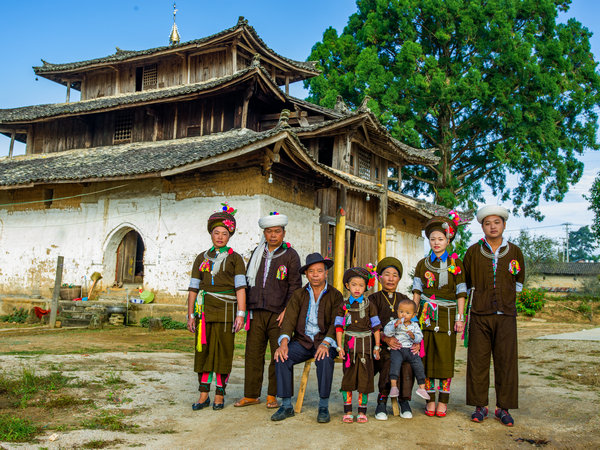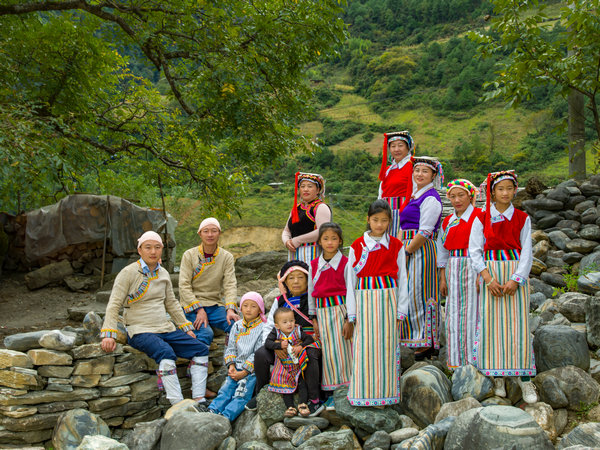A picture of diversity

A family photo taken by photographer Chen Lin of the Wa ethnic groups in Southwest China's Yunnan province.[Photo provided to China Daily]
Four years ago, when photographer Chen Lin traveled to a rural village inhabited by the Miao ethnic group in Southwest China's Guizhou province, he happened to encounter a local wedding, where the bride wore a traditional handmade Miao-style costume-with sophisticated embroidery that had taken several years to finish-while the groom was in a modern suit. Chen was surprised because, among the Miao people, even the man usually wears a dazzling costume for his wedding, known for its silver decoration and fancy embroidery.
The groom told Chen that he left the village to work in a big city five years ago. The young man thought the modern suit is more fashionable and convenient to wear than Miao costumes. It was then that the photographer recognized the need to record the diverse costumes and architecture of China's different ethnic groups.
"If I don't start taking photos, I'm afraid these things will fade into memory and, in as little as 10 years, it will be impossible to see these traditional aesthetics," says Chen, referring to the inevitable influence of modernization on the lives of the ethnic groups.
Since 2016, Chen has devoted himself to his five-year project to take photos of the families of 56 ethnic groups living in different provinces in China. His tally so far is 37 of the groups.
Each ethnic group has their own culture and language. The simple way to identify them is by their appearance and their houses. Chen decided to focus on families in traditional costume, especially big families with four generations all together.

A family photo taken by photographer Chen Lin of the Achang ethnic groups in Southwest China's Yunnan province.[Photo provided to China Daily]
"Family is what we Chinese value most. It was believed that having four generations living under the same roof is a signal of the prosperity and happiness of a family. To live together may not always be possible now, but I can frame them together," says Chen.
The biggest family photo, in terms of the number of people, was taken in Yunnan province, in which the father gathered eight daughters who live in different counties. Single families can sometimes reach up to 50 members.
Chen says in his photos, it's common to see that the elders usually wear traditional self-made clothes, while the younger generation opts to buy their costumes. Sometimes, the youngsters wear high-heels or sneakers because they can't find traditional shoes.
"I never force them to wear traditional costume if they don't have it. That's what happens," Chen says.

A family photo taken by photographer Chen Lin of the Nu ethnic groups in Southwest China's Yunnan province.[Photo provided to China Daily]
It takes a woman upward of one year to weave a traditional dress. For the Miao ethnic group, a bride often starts to stitch her wedding gown as a teen.
To find his subjects-people from an ethnic group keeping part of their traditional lifestyle alive-Chen has to drive hundreds of miles to rural areas.
Often, there were places that a car couldn't reach, so he had to go by motorbike, even though, with the country's fast development, the transportation to rural places inhabited by ethnic groups has improved greatly, adds Chen.
In Yunnan, the Derung ethnic group is one of China's smallest ethnic groups in terms of population and known for the facial tattoos sported by the women.
Chen says they told him that years ago, when relatives who lived on other mountains came to visit during winter, one night's stay would turn into months because of the long, arduous journey involved. Now, modern roads make it easy to visit distant family members.
"In just a few years, great changes have happened," he says.
The young replaced their old houses with modern ones after returning from working in the cities. Some even can't speak their own language since their culture doesn't have writing.

Photographer Chen Lin (left) takes a group photo with a family of four generations, the eldest member of which is 84 years old, from the Lisu ethnic group in Yunnan in 2018. [Photo provided to China Daily]
Chen says he sometimes worries that the speed at which he is taking pictures can't catch up with the pace at which the cultures are receding. However, he takes comfort that the government's programs to raise awareness is gradually awakening people's desire to protect their culture.
In November, he went to take photos of the Li ethnic group in Hainan province, a group of more than one million. The group's traditional houses are built like up-side-down boats.
Chen was told that years ago, locals didn't wear their costumes and felt ashamed of their own identity because they were regarded as poor. With the fast development of local tourism, people now are proud of their culture and are actively protecting it.
Chen employs a traditional film camera to take large frame photos that can end up being presented as pictures more than a meter high. His photo equipment is much heavier than that used with digital cameras. That's why driving to his destination is a convenient way for him to take all of his gear, which weighs more than 100 kilograms.
Chen uses "friendly and nice" to describe the different people he has met. He remembers two Tibetan women who helped him carry his heavy equipment to the top of a mountain. Locals treated him to delicious food and provided beds for him, all for free.
"Although each ethnic group has its own personality, we Chinese are a big family."
All of his subjects are now gathered in an online chat group. It consists of hundreds of people from diverse ethnic groups and, although they're strangers to each other, they communicate with each other about their local cuisine, landscape and daily life.
Every year, Chen spends two months driving and photographing. The rest of the time he works as a film director and commercial photographer to support his special project.
The Beijing-based photographer is planning a trip to the Xinjiang Uygur and Tibet autonomous regions in August to capture images of families there. Apart from taking photos, he will start using short films to document his mission and better record the unique culture of each group.
"The more I learn about each culture, the more I want to record. They're fascinating."
Editor: John Li